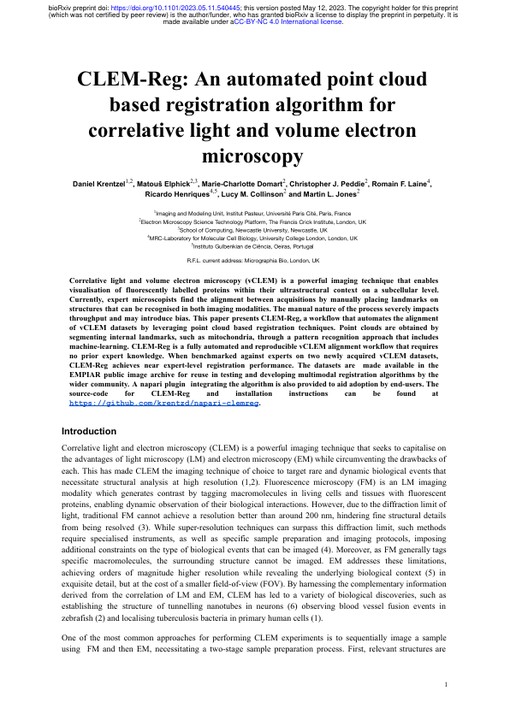Technology

CLEM-Reg is an automated workflow for registering correlative light and volume electron microscopy (vCLEM) datasets. vCLEM involves acquiring two sequential 3D image stacks of the same sample - one using fluorescence microscopy (FM) to image fluorescently tagged proteins, and one using volume electron microscopy (vEM) to reveal ultrastructural details at much higher resolution. To correlate the FM and vEM data, the image stacks need to be aligned as they are acquired at different orientations with some deformation occurring during sample preparation.
Traditionally, vCLEM alignment relies on experts manually identifying corresponding landmarks across the modalities to calculate a transformation. However, this manual process is laborious, prone to bias, and limits throughput. CLEM-Reg aims to automate this alignment in a fast, unbiased manner without needing expert knowledge.
The key innovation of CLEM-Reg is the use of an internal landmark for registration that is different from the target structure being studied. This avoids biasing the alignment towards the target. CLEM-Reg segments mitochondria in both the FM and vEM data as they are abundant, distributed cell landmarks. The segmented mitochondria are turned into point clouds by randomly sampling surface points. As there's no guaranteed point correspondence across modalities, CLEM-Reg uses probabilistic point cloud registration algorithms called Coherent Point Drift (CPD) and BCPD. These align the FM and vEM point clouds to calculate a transformation between the volumes. Finally, this transform warps the FM onto the vEM data to create an overlay.
In the FM, CLEM-Reg segments mitochondria using a 3D Laplacian of Gaussian filter and dynamic thresholding. In the vEM, it leverages a pretrained deep learning model called MitoNet. To reduce computational load, the point clouds are downsampled before registration. Rigid CPD alignment is fast but can be refined with BCPD for non-linear warping if needed. For the final overlay, rigid transformation of the FM is usually sufficient.
CLEM-Reg is accessible via a user-friendly plugin for the napari image viewer. It allows single-click automation or tuning of individual steps like changing the segmentation methods. The plugin outputs overlays and point clouds for inspection and records chosen parameters for reproducibility.
To benchmark performance, CLEM-Reg was tested on two vCLEM datasets alongside manual alignment by experts. Target structures separate from the registration landmark were tagged and agreement metrics calculated. CLEM-Reg achieved near expert-level registration accuracy in a fully automated manner.
CLEM-Reg introduces a novel workflow to automate the traditionally manual vCLEM alignment process. By using an internal landmark and point cloud registration, it achieves unbiased, reproducible correlations between FM and vEM modalities. The napari plugin and public benchmark datasets lower barriers to adoption. CLEM-Reg represents an important step towards high-throughput CLEM experiments.
Publications featuring CLEM-Reg

|
CLEM-Reg - An automated point cloud based registration algorithm for correlative light and volume electron microscopy Daniel Krentzel, Matouš Elphick, Marie-Charlotte Domart, Christopher J. Peddie, Romain F. Laine, Ricardo Henriques, Lucy M. Collinson, Martin L. Jones Preprint published in bioRxiv, May 2023 Technologies: BioImage Model Zoo (), CARE (), CLEM-Reg () and ZeroCostDL4Mic () Funded by: CZI DOI: 10.1101/2023.05.11.540445 |
|
Funding contributing to CLEM-Reg

|
VirusAwareScopes - Machine Learning-Driven Adaptive Microscopy for Long-Term Viral Infection Studies Ricardo Henriques Alias: VirusAwareScopes Funded by: La Caixa Foundation - Health Research Duration: November 2025 - October 2028 |